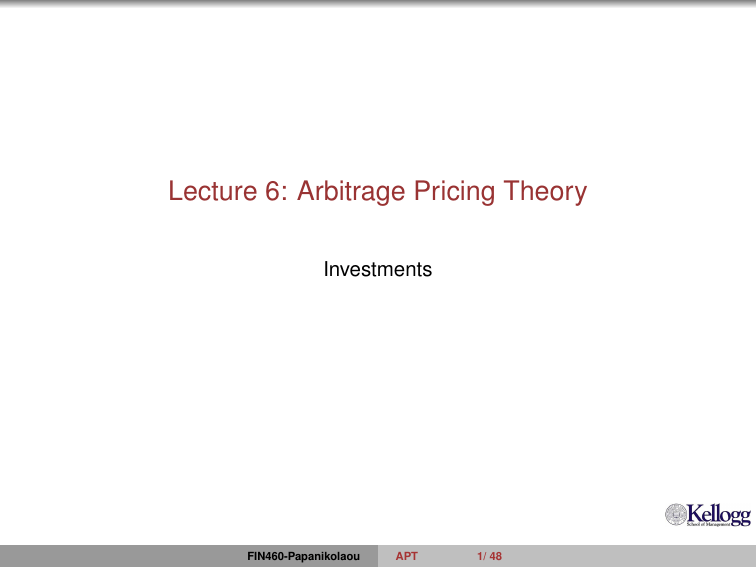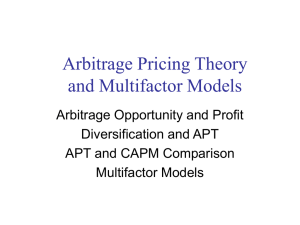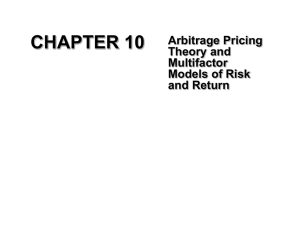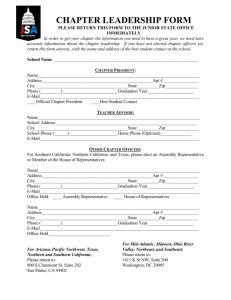Lecture 6: Arbitrage Pricing Theory
advertisement

Lecture 6: Arbitrage Pricing Theory Investments FIN460-Papanikolaou APT 1/ 48 Overview 1. Introduction 2. Multi-Factor Models 3. The Arbitrage Pricing Theory FIN460-Papanikolaou APT 2/ 48 Introduction The empirical failure of the CAPM is not that surprising: ,→ We had to make a number of pretty unrealistic assumptions to prove the CAPM. ,→ For example, we made the assumption that investors had identical preferences, had the same information, and hold the same portfolio (the market). ,→ Also, there is the problem that identifying and measuring the market return is difficult, if not impossible (the Roll Critique) In this lecture we will study a different approach to asset pricing called the Arbitrage Pricing Theory or APT. The APT specifies a pricing relationship with a number of “systematic” factors. FIN460-Papanikolaou APT 3/ 48 Returns Are Multi-Dimensional Barr Rosenberg, “Extra Market Components of Covariance in Security Markets,” Journal of Financial and Quantitative Analysis, 1974: “Companies possessing similar characteristics may, in a given month, show returns that are different from the other companies. The pattern of differing shows up as the factor relation.” A set of common factors - not just a monolithic market - influence returns FIN460-Papanikolaou APT 4/ 48 Comovement Stocks in the same industry tend to move together. Example: European Banks Source: BARRA FIN460-Papanikolaou APT 5/ 48 Comovement However, there are other common factors that simultaneously affect returns. Within the banking industry, the size factor is at work Source: BARRA FIN460-Papanikolaou APT 6/ 48 Multiple factors and the CAPM The presence of multiple factors makes the CAPM a much more restrictive theory. Consider two sources of risk, “technology” and “monetary policy”. ,→ Do all stocks respond the same way to technological innovation? ,→ Do all stocks respond the same way to changes in interest rates? Assume that RM = RT + RI , ,→ CAPM then implies that E[Ri ] = r f + (E(Rm ) − r f ) βi where βi ≡ cov(Ri , Rm ) cov(Ri , RT ) + cov(Ri , RI ) = var(Rm ) var(Rm ) CAPM says that both covariances are priced exactly the same. FIN460-Papanikolaou APT 7/ 48 Arbitrage Pricing Theory The APT is an approach to determining asset values based on law of one price and no arbitrage. It is a multi-factor model of asset pricing. The APT is derived from a statistical model whereas the CAPM is an equilibrium asset pricing model. ,→ To get the APT, we don’t have to assume that everyone is optimizing. ,→ Recall that we did need this assumption to get the CAPM. ,→ This makes the APT a much more “reasonable” theory. Unlike the CAPM, we need very few assumptions to get the APT. FIN460-Papanikolaou APT 8/ 48 APT Assumptions The assumptions necessary for the APT are: a) All securities have finite expected values and variances. b) Some agents can form well diversified portfolios c) There are no taxes d) There are no transaction costs Notice that we have considerably fewer than with the CAPM! The central idea behind the APT will be that we can price some assets relative to other assets. a) We will derive restrictions on the price of assets based on no-arbitrage. b) We will be able to say something stronger if we exclude “near-arbitrage” or extremely good deals. FIN460-Papanikolaou APT 9/ 48 Specifying Uncertainty We need a systematic way of thinking about uncertainty or risk in a dynamic setting. We will assume that investors know exactly which states of nature can occur, and exactly what will happen in each of the states. We know which states are possible, but not which will actually occur: ,→ We only know what the probabilities of each of the states are. ,→ You can think of this as meaning that we can always draw a multi-branched tree for the world. One implication is that investors know what the price of each and every security will be if the economy evolves in a particular way. With standard factor models, there are an infinite number of states of nature, since the factors can take on any values. FIN460-Papanikolaou APT 10/ 48 No Arbitrage Pricing restrictions in the APT come from the Absence of Arbitrage. Absence of Arbitrage in financial markets means that NO SECURITY EXISTS WHICH HAS A NEGATIVE PRICE AND A NON-NEGATIVE PAYOFF. ,→ Also, no security can be created which has this property. This rule also implies that: a) Two securities that always have the same payoff must have the same price. b) No security exists which has a zero price and a strictly positive payoff. This is the same idea that has been applied to option pricing! FIN460-Papanikolaou APT 11/ 48 No Arbitrage 1. In an efficiently functioning financial market arbitrage opportunities should not exist (for very long). 2. Unlike equilibrium rules such as the CAPM, arbitrage rules require only that there just one intelligent investor in the economy. ,→ This is why derivatives security pricing models do a better job of predicting prices than equilibrium based models. ,→ In this lecture, we will see how to apply the same concept to pricing portfolios of assets. 3. If arbitrage rules are violated, then unlimited risk-free profits are possible. FIN460-Papanikolaou APT 12/ 48 Arbitrage - Example Suppose that there are only two possible states for Inflation and Interest Rates: high or low We know exactly how four securities will perform in each of the possible states: State/ Stock High Real Int. Rates High Infl. Low Infl. Low Real Int. Rates High Infl. Low Infl. Int. Rate Inflation 5% 10% 5% 0% 0% 10% 0% 0% Prob. 0.25 0.25 0.25 0.25 Apex (A) Bull (B) Crush (C) Dreck (D) -20 0 90 15 20 70 -20 23 40 30 -10 15 60 -20 70 36 FIN460-Papanikolaou APT 13/ 48 Arbitrage - Example Let’s assume the prices of each of the four securities are $100 and calculate expected returns, standard deviations and correlations: Everything looks normal here, but there is a simple arbitrage opportunity lurking in these numbers! Stock Current Price Expect. Return(%) Standard Dev. (%) A A B C D 100 100 100 100 25.00 20.00 32.50 22.25 29.58 33.91 48.15 8.58 1.00 -0.15 -0.29 0.68 FIN460-Papanikolaou APT Correlation Matrix B C 14/ 48 -0.15 1.00 -0.87 -0.38 -0.29 -0.87 1.00 0.22 D 0.68 -0.38 0.22 1.00 Arbitrage - Example Consider the return of an Equal-Weighted portfolio of A, B and C, and compare this with the return of D: State/ Port. High Real Int. Rates High Infl. Low Infl. EW Port. of A,B,C Dreck (D) 23.33 15 Low Real Int. Rates High Infl. Low Infl. 23.33 23 20.00 15 36.67 36 This table shows that the return of the EW portfolio is higher in all states, this means that there is an arbitrage opportunity. What would happen to the price of D in a well functioning market? FIN460-Papanikolaou APT 15/ 48 Arbitrage - Example Based on the arguments presented earlier, we will take the position that arbitrage opportunities cannot exist (for very long!). That means that there is something wrong with these prices. Our goal in this lecture is to come up with a model of security prices where: a) If prices/returns obey this model, there is no arbitrage. b) If prices/returns fail to obey this model, there is arbitrage. FIN460-Papanikolaou APT 16/ 48 Arbitrage Pricing Theory The previous example here is too restrictive. In reality: 1. An infinite number of states are possible 2. There are generally a large number of factors, and a continuum of possible factor realizations. The factor model framework gives us a systematic way of describing how expected security returns must relate to their comovement with the economy. If there is to no arbitrage in the economy, the we can also price assets relative to one another based on their comovement with these factors. This is the basis of the APT. FIN460-Papanikolaou APT 17/ 48 Arbitrage Pricing Theory First we need a Factor Model (or Return Generating Process (RGP)), which is a mathematical expression for how the security returns move with economic factors: ,→ We will call the sources of movement factors ,→ We will call the stock sensitivities to the factors factor loadings (or, equivalently, factor betas or factor sensitivities). We have already seen an example of such a model. It is the single-index model that we used to simplify the correlation structure between securities. FIN460-Papanikolaou APT 18/ 48 Factor Model The Factor Model (or RGP) is: r̃i − E(r̃i ) = bi,1 f˜1 + ... + bi,K f˜K + ẽi The fi ’s are common factors that affect most securities. Examples are economic growth, interest rates, and inflation. We require that, for each of the factors, E( f˜i ) = 0. This means that, instead of defining an f directly as economic growth, we would have to define it as the deviation of economic growth from what was expected. Often we assume cov( f˜i , f˜j ) = 0 for i 6= j. FIN460-Papanikolaou APT 19/ 48 Factor Model The Factor Model (or RGP) can be written as: r̃i = E(r̃i ) + bi,1 f˜1 + ... + bi,K f˜K + ẽi bi, j denotes the loading of the i’th asset on the j’th factor. This tells you how much the asset’s return goes up when the factor is one unit higher than expected. The ẽi in this equation is idiosyncratic risk. ,→ For example, ẽi will be negative when a firm’s president dies, or a firm loses a big contract. ,→ We will assume that cov(ẽi , ẽ j ) = 0 for all securities i and j. FIN460-Papanikolaou APT 20/ 48 Factor Model - Example An example using this return generating process (BKM, chapter 10): Suppose that two factors have been identified for the U.S. economy: the growth rate of industrial production, IP, and the inflation rate, IR. IP is expected to be 4%, and IR 6%. A stock with a beta of 1.0 on IP and 0.4 on IR currently is expected to provide a rate of return of 14%. If industrial production actually grows by 5%, while the inflation rate turns out to be 7%, what is your revised estimate of the realized return on the stock? FIN460-Papanikolaou APT 21/ 48 Factor Model - Example We know E(IP) = 4% and bIP = 1, E(IR) = 6%, bIR = .4, and E(ri ) = 14% The two factors are therefore: fIP = (0.05 − 0.04) = 0.01 fIR = (0.07 − 0.06) = 0.01 Plug these into the return generating process gives the expected return conditional on these realization of the industrial production growth rate (IP) and the inflation rate (IR): E(r̃i | fIP , fIR ) = 0.14 + 1 · 0.01 + 0.4 · 0.01 = 15.4% ,→ What about the idiosyncratic risk (ei )? FIN460-Papanikolaou APT 22/ 48 Factor Model Using the return generating process we can calculate the variance of this portfolio as (for two factors): var(Ri ) = var bi,1 f˜1 + bi,2 f˜2 + ẽi = b2i,1 var( f1 ) + b2i,2 var( f2 ) + 2 · bi,1 · bi,2 · cov( f˜1 , f˜2 ) + σ2e,i = b2i,1 var( f1 ) + b2i,2 var( f2 ) + σ2e,i (if factors are uncorrelated) the general formula for n factors: n σ2i = n ∑ ∑ bi, j · bi,k · σ j,k + σ2e,i j=1 k=1 where σ j,k denotes the covariance between the j’th and k’th factors. (What is σ2,2 ?) 1. The systematic variance is ∑nj=1 ∑nk=1 bi, j · bi,k · σ j,k . 2. The idiosyncratic variance is σ2e,i . FIN460-Papanikolaou APT 23/ 48 Factor Model Under the factor model, the covariance between two stocks, i and j (for two factors) cov(Ri , R j ) = cov(bi,1 f1 + bi,2 f2 + ei , b j,1 f1 + b j,2 f2 + e j ) = bi,1 b j,1 var( f1 ) + bi,2 b j,2 var( f2 ) + +(bi,1 b j,2 + b j,1 bi,2 ) cov( f1 , f2 ) = bi,1 b j,1 var( f1 ) + bi,2 b j,2 var( f2 ) (if factors are uncorrelated) FIN460-Papanikolaou APT 24/ 48 Factor Model Examples of factor models: a) The Fama-French 3-factor model of returns. b) The 3-factor model of the term-structure (level, slope, curvature). The APT will give a theoretical justification for the use of empirical factor models in determining the “fair” rate of return. Multi-Factor Models vs the CAPM ,→ Does a well-diversified portfolio have any idiosyncratic risk? ,→ How do our “APT” definitions of a systematic and idiosyncratic risk differ from the CAPM definitions? ,→ How does our “APT” definition of a well-diversified portfolio differ from the CAPM definition? FIN460-Papanikolaou APT 25/ 48 Definitions In the context of the APT, a diversified portfolio is a portfolio that carries no idiosyncratic risk: r̃ p − E(r̃ p ) = b p,1 f˜1 + ... + b p,K f˜K ,→ This is defined relative to a specific factor model. ,→ We will assume that investors can form such diversified portfolios. In the context of the CAPM, you may see different definitions: 1. A diversified portfolio will have the least variance for a given level of expected returns. I ALL minimum-variance efficient portfolios are diversified according to this definition. 2. A diversified portfolio will have zero idiosyncratic risk, i.e. it will have an R2 with the market. I ONLY the market portfolio (and combinations of this with the riskless asset, i.e. portfolios on the CAL) will be diversified according to this definition. FIN460-Papanikolaou APT 26/ 48 Arbitrage Pricing Theory The APT Pricing Equation is: E(r̃i ) = λ0 + λ1 bi,1 + ... + λK bi,K This equation specifies that the relation between the expected return of a security and its factor loadings (bs) is linear. ,→ The λs or factor risk premia tell you how much extra return you get for each extra unit of risk your portfolio has. ,→ Note that there is one λ for each factor in the economy, plus one extra: λ0 . ,→ If there is a risk-free asset, then it must be the case that portfolios with no risk (with all bs equal to zero) have a return of the risk-free rate, i.e., that λ0 = r f . How does it compare to the CAPM? FIN460-Papanikolaou APT 27/ 48 APT - Example Here we will use a simple example to understand how investors price risky securities. This will allow us to better understand what each of the the elements of the Arbitrage Pricing Theory. We will try to better understand what Risk means in the APT context, and to try to better define and understand the following terms: ,→ Factor ,→ Factor Loading ,→ Factor Risk-Premia ,→ Arbitrage To start out, let’s look again at how we specify uncertainty in the APT setting. ,→ Note that this is the specification used in most of finance and economics, including in derivatives securities pricing. FIN460-Papanikolaou APT 28/ 48 APT - Example Suppose that we know that IBM is going to pay a liquidating dividend in exactly one year, and this is the only payment that it will make. However, that dividend that IBM pays is uncertain – its size depends on how well the economy is doing. ,→ If the economy is in an expansion, then IBM will pay a dividend of 140. ,→ However, if the economy is in a recession, then its dividend will be only 100. ,→ If the two states are equally likely, the expected cash flow from IBM is E(CF1IBM ) = 120. Note that, consistent with our definition of uncertainty, we know exactly what will happen to IBM in each scenario, but we don’t know which scenario will occur. FIN460-Papanikolaou APT 29/ 48 APT - Example IBM Boom Payoff (Pr=0.5) Bust Payoff (Pr=0.5) 140 100 E(CF1 ) Time 0 Price 120 100 20% Discount Rate Assuming that the price of IBM is $100, we see that investors in this economy are applying a discount rate of 20% to IBM’s expected cash-flows. The way they come up with the price of IBM is to take the expected cash flow at time 1 from IBM, E(CF1IBM ) = $120, and discount this cash-flow back to the present at the “appropriate” discount rate, which is apparently 20%. Equivalently, we can say that the expected return of IBM is 20%. FIN460-Papanikolaou APT 30/ 48 APT - Example Now let’s consider a second security, DELL which, like IBM, will pay a liquidating dividend in one year, and which has only two possible cash flows, depending on whether the economy booms or goes into a recession over the next year. IBM DELL Boom Payoff (Pr=0.5) Bust Payoff (Pr=0.5) 140 100 160 80 E(CF1 ) Time 0 Price 120 100 20% 120 ? ? Discount Rate Now let’s consider how investors will “price” DELL. Note the IBM and DELL have the same expected cash-flow, so one might guess that a reasonable price for DELL might also be $100. FIN460-Papanikolaou APT 31/ 48 APT - Example However, even though the expected cash-flows for DELL are the same, we see that the pattern of cash flows across the two states are probably worse for DELL: DELL’s payoff is lower in the bust/recession state, which is when we are more likely to need the money. It only does better when things are good. ,→ The recession is when the rest of our portfolio is more likely to do poorly, and when we are more likely to lose our job, and our consulting income is likely to be lower. We “need” the cash more in a recession ,→ In the boom/expansion, our portfolio will probably do better; we’re more likely to have a good job; we’ll probably have more consulting income. This means that if DELL were the same price as IBM, we would buy IBM. FIN460-Papanikolaou APT 32/ 48 APT - Example Therefore, to induce investors to buy all of the outstanding DELL shares, it will have to be the case that DELL’s price is lower than $100. Also, note that the three are statements are equivalent: ,→ The price investors will pay for DELL will be less than $100, even though DELL’s expected cash flows are the same as IBM’s. ,→ The discount rate investors will apply to DELL’s cash flows will be higher than the 20% applied to IBM’s cash flows. ,→ The expected return investors will require from DELL will be higher than the IBM’s expected return of 20%. Let’s assume that investors are only willing to buy up all of DELL’s shares if the price of DELL is $90, or, equivalently, that the discount rate that they will apply to DELL is 33.33%: E(RDELL ) = E(CF1DELL ) − PDELL 120 − 90 30 = = = 0.3333 PDELL 90 90 FIN460-Papanikolaou APT 33/ 48 APT - Example IBM DELL Boom Payoff (Pr=0.5) Bust Payoff (Pr=0.5) 140 100 160 80 E(CF1 ) Time 0 Price 120 $100 20% 120 $90 33.33% Discount Rate The way to think about expected returns is that this is something that investors determine. After looking at the pattern of cash-flows from any investment, and deciding whether they like or dislike this pattern, investors determine what rate they will discount these cash flows at (to determine the price.) This rate is what we then call the “expected return.” Since investors accurately calculate the expected cash-flows, the average return they realize on the investment will be the discount rate. FIN460-Papanikolaou APT 34/ 48 APT - Example Now let’s see how all of this relates to the APT equations: 1. Calculating the business cycle factor fBC in the two states: ,→ First, assume that we use the NBER (National Bureau of Economic Research) business cycle indicator to construct our factor. I The indicator is one (at the end of the next year) if the economy is in an expansion, and zero if the economy is in a recession. ,→ However, remember that for the factor, we need the unexpected component of the business cycle. ,→ Assuming there is a 50%/50% chance that we will be in an expansion/recession, the expected value of the indicator is 0.5. ,→ This means that the business-cycle factor has a value of 0.5 = 1 − 0.5 if the economy booms, and −0.5 = 0 − 0.5 if the economy goes bust. FIN460-Papanikolaou APT 35/ 48 APT - Example 2. Calculating the factor loadings for the two securities: ,→ The way of doing this is to run a time-series regression of the returns of IBM on the factor. Let’s do this first for IBM: rIBM,t = E(rIBM ) + bIBM,BC · fBC,t + eIBM,t where E(rIBM ) is the intercept and bIBM,BC is the slope coefficient. ,→ Here, we have only two points, so we can fit a line exactly: 0.40 = E(rIBM ) + bIBM,BC · 0.5 0.00 = E(rIBM ) + bIBM,BC · −0.5 (boom) (bust) ,→ Solving these gives E(rIBM ) = 0.20 (which we already knew) and bIBM,BC = 0.4. ,→ Similar calculations for DELL gives E(rDELL ) = 0.3333 and bDELL,BC = 0.8889. FIN460-Papanikolaou APT 36/ 48 APT - Example 3. Interpreting the factor loadings. ,→ The factor loadings bIBM,BC and bDELL,BC tell us how much risk IBM and DELL have. ,→ Risk means that the security moves up or down when the factor (the business cycle) moves up and down. ,→ Based on the way that we have characterized uncertainty, the expected return and the factor loading bi,BC of each security tell us everything that we need to know to calculate all of the payoff, per dollar, in every state of nature. a) This will be true for every well-diversified portfolio, in every factor model. b) One way of thinking about this is that the expected return tells us what the reward is, and the b’s tell us what the risk of the security is. FIN460-Papanikolaou APT 37/ 48 APT - Example 4. Calculating the factor risk premia (λ’s) ,→ The Factor Model tells us nothing about why investors are discounting the cash flows from the different securities at different rates. ,→ To determine how investors view the risks associated with each of the risks in the economy, we have to evaluate the APT Pricing Equation. ,→ Now that we have the factor loadings, we can determine the factor risk-premia (or λ’s), by regressing expected returns Eri on factor loadings bik . ,→ Since there is only one factor and two stocks E(rIBM ) = λ0 + λBC · bIBM,BC E(rDELL ) = λ0 + λBC · bDELL,BC to which the solutions are λ0 = 0.0909 and λBC = 0.2727. FIN460-Papanikolaou APT 38/ 48 APT - Example 5. Interpreting the risk-premia (λs): ,→ DELL is considered to be a riskier security than IBM, in the sense that investors discount DELL’s cashflows at a higher rate than IBM. ,→ This is reflected in DELL’s higher loading on the BC factor. ,→ The λBC is a measure of how much more investors discount a stock as a result of having one extra unit of risk relating to the BC factor. ,→ λ0 tells you how high a return investors require if a security has no risk. FIN460-Papanikolaou APT 39/ 48 APT - Example Using the set of securities that we used to calculated the λ’s for the pricing equations, we can always construct a portfolio p with any set of factor loadings (b p,k ). The pricing equation then tells us what the expected return (or discount rate) for the portfolio of securities is. Alternatively, this equation tells us, if we find a (well-diversified) portfolio with certain factor loadings, what discount-rate that portfolio must have for there to be no arbitrage. Finally, if we add a third security to the mix and calculate its factor loadings, the APT will tell us what its expected return must be in order to avoid arbitrage opportunities. Essentially what we doing is pricing securities relative to other securities, in much the same way we are pricing derivatives relative to the underlying security. FIN460-Papanikolaou APT 40/ 48 Finding Arbitrages Arbitrage arises when the price of risk differs across securities. 1. If investors are pricing risk inconsistently across securities, than, assuming these securities are well diversified, arbitrage will be possible. 2. To see this, let’s extend the example to include a risk-free asset which we can buy or sell at a rate of 5%. I That is the rate for borrowing or lending is 5%. 3. Since λ0 = 0.0909, we know that we can combine DELL and IBM in such a way that we can create a synthetic risk-free asset with a return of 9.09%. 4. So we borrow money at 5% (by selling the risk-free asset) and lend money at 9.09% FIN460-Papanikolaou APT 41/ 48 Building the Arbitrage Portfolio To determine how much of IBM and DELL we buy/sell, we solve the equation for the weights on IBM and DELL in a portfolio which is risk-free: wIBM · bIBM,BC + (1 − wIBM ) · bDELL,BC = b p,BC = 0 or wIBM = bDELL,BC = 1.8182 bELL,BC − bIBM,BC and wDELL = (1 − wIBM ) = −0.8182. This means that, to create an arbitrage portfolio, we can invest $1.8182 in IBM, short $0.8182 worth of DELL, and short $1 worth of the risk-free asset. This portfolio requires zero initial investment and has a positive payoff in all states. FIN460-Papanikolaou APT 42/ 48 Building the Arbitrage Portfolio To verify that this works, lets look at the payoff to the IBM/DELL risk-free portfolio in the two states: Payoff(boom) = wIBM · (140/100) + (1 − wIBM ) · (160/90) = 1.0909 Payoff(bust) = wIBM · (100/100) + (1 − wIBM ) · (80/90) = 1.0909 This means that the payoff from the zero-investment portfolio is $0.0409 = 1.0909 − 1.05 in both the boom and bust states. So this portfolio (in this simple economy) is risk free. Of course, we can scale this up as much as we like. For $1 million investment in the long and short portfolios, we would get a risk-free payoff of $40,900 (assuming prices did not move with our trades) FIN460-Papanikolaou APT 43/ 48 Interpreting the Arbitrage What is going on here is that investors are pricing risk inconsistently across securities. With any pair of securities, we can calculate λ0 and λBC , however, each pair of securities will give you a different set of λ’s: Security 1 Security 2 λ0 λBC IBM IBM DELL DELL RF RF 0.0909 0.05 0.05 0.2727 0.3750 (= (0.2 − 0.05)/0.4) 0.3187 (= (0.3333 − 0.05)/0.8889) This means that, to find the arbitrage, we could have 1. calculated the λ’s using any pair of securities, and then 2. calculated the expected return (or discount rate) for the third security 3. bought the high return and sold the low return. FIN460-Papanikolaou APT 44/ 48 Interpreting the Arbitrage Whenever this happens, there will be an arbitrage. If there are arbitrageurs in the economy, they will move prices until the arbitrage disappears, and risk is priced consistently. This is the argument behind the APT. Note that this assumes however that the arbitrageurs have unlimited capital and patience. We will see later that in some cases that this may be an erroneous assumption and in fact, there may be limits to arbitrage. FIN460-Papanikolaou APT 45/ 48 Summary What have we learned? 1. Here, we have used a simple example to understand how investors price risky securities. 2. The idea behind the APT is that investors require different rates of return from different securities, depending on the riskiness of the securities. 3. If, however, risk is priced inconsistently across securities, then there will be arbitrage opportunities. 4. Arbitrageurs will take advantage of these arbitrage opportunities until prices are pushed back into line, risk is priced consistently across securities, and arbitrages disappear. FIN460-Papanikolaou APT 46/ 48 Glossary We have defined the following terms: Factors ( f˜’s) move up and down with the economy, and affect the future cash flows of securities. Factor loadings (b’s) for each security, for each factor, tell you how much the security moves (on average, in percent) when the factor moves by 1%. Factor risk-premia: (λ’s) for each factor, tell you how much higher a discount-rate investors apply to a security if its factor loading on a particular factor is higher by one. Arbitrage arises if risk is priced inconsistently across (well-diversified) securities. ,→ One way of thinking about this is that we can find two well diversified securities/portfolios, with exactly the same risk/factor-loadings, which have their cash flows discounted at different discount rates. FIN460-Papanikolaou APT 47/ 48 Summary The APT is an alternative model to the CAPM. It makes fewer assumptions, and as a result gets weaker predictions. In particular, the APT does not say what the systematic factors are, whereas the CAPM says that the market portfolio is the only systematic source of risk. Later: How to specify the factors? a) Factors can be specified a priori: they could be macroeconomic variables (ex inflation, output) that capture the systematic risk in the economy or portfolios proxying for these risks. b) Factors can be extracted via Principal Components or Factor Analysis. FIN460-Papanikolaou APT 48/ 48





